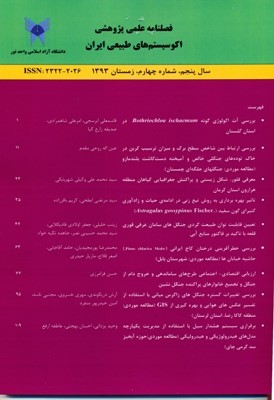تاثیر بهره برداری به روش تیغ زنی در ادامه ی حیات و زادآوری کتیرای گون سفید (Astragalus gossypinus Fischer.)
محورهای موضوعی : جنگلداریسید مرتضی ابطحی 1 * , کریم باقرزاده 2
1 - استادیار پژوهشی بخش تحقیقات منابع طبیعی، مرکز تحقیقات و آموزش کشاورزی و منابع طبیعی استان اصفهان، سازمان تحقیقات، آموزش و ترویج کشاورزی، اصفهان، ایران
2 - مربی پژوهشی بخش تحقیقات منابع طبیعی، مرکز تحقیقات و آموزش کشاورزی و منابع طبیعی استان اصفهان، سازمان تحقیقات، آموزش و ترویج کشاورزی، اصفهان، ایران
کلید واژه: بهرهبرداری محصولات فرعی, تیمار تیغ زنی, تاج پوشش, کتیرا, گون سفید,
چکیده مقاله :
چکیده کتیرا یکی از محصولات فرعی مهم و صادراتی مراتع استان اصفهان میباشد که از گونه Astragalus gossypinus استحصال می گردد. استفاده بی رویه و ناصحیح، در سال های اخیر موجب تخریب گسترده رویشگاههای طبیعی این گیاه شده است. این تحقیق به منظور بررسی تأثیر بهره برداری، در ادامه حیات و زادآوری گونه مذکور در منطقه یحیی آباد نطنز از 1379 شروع و تا سال 1385 ادامه یافت. در این پژوهش از آزمون اسپلیت پلات بر پایه بلوک های کامل تصادفی تحت تیمار تعداد تیغ (2 و 3 تیغ در هر پایه) و دفعات برداشت در سال (2، 4 و 6 نوبت) با 3 تکرار استفاده گردید. کرت های آزمایش شامل30 بوته که برای اولین بار مورد بهرهبرداری قرار می گرفتند بودند. در این کرت ها میزان محصول، درصد تلفات بوته در اثر بهره برداری، وزن هزار دانه و تاج پوشش بوته ها اندازه گیری و نتایج حاصل آنالیز گردید. نتایج نشان داد که بهره برداری، روی درصد تاج پوشش گونه تأثیر منفی داشته و رشد را محدود می سازد. همینطور تعداد تیغ (2 و 3 تیغ) روی تولید محصول اثر معنی دار ندارد. در مجموع با توجه به درصد تلفات بوته، تیمارهای دو تیغ و چهار مرتبه برداشت در طول دوره بهره برداری توصیه می گردد.
Abstract Gum tragacanth is one of the most important medicinal and industrial products of rangelands, obtained from the scarification of gum tragacanth-producing Astragalus including Astragalus gossypinus. This species is threatened with extinction due to the non-normative exploitation. This research was aimed to provide a scientific method for the exploitation of gum tragacanth as well as the conservation and survival of this species. The study was conducted in two regions of Isfahan province using a random complete blocks design in a factorial scheme with three replications. Each replication included 30 shrubs that were exploited for the first time. Treatments included the number of scarification and harvesting. The traits included the amount of gum tragacanths obtained from each replication, the percentage of plant mortality, canopy cover, and 1000-seed weight. According to the obtained results, the number of harvesting had a negative impact on canopy cover. The number of scarification and harvesting and their interaction effect on product was not significant. Overall, two scars and four-times harvesting could be recommended for the exploitation of A. gossypinus.
References
1-Abdollah poor, M., 2014. Tragacanth product that culture must be revived. Iran's Islamic Republic News Agency.
2-Akbarian, M., 1999. Final report of tragacanth utilization in Yahya abad rangelands of Natanz, Natural recourses office of Isfahan.
3-Al-Tamimi, M., R. Palframan, J. Cooper, G. Gibson, & R. Rastall, 2006. In vitro fermentation of sugar beet arabinan and arabino-oligosaccharides by the human gut microflora.Jounal of Applied Microbiology 100(2): 407-414.
4-Asadian, Gh. & A. Barati, 2006. Investigation of effect of number and type of incision in different times on amount of gum tragacanth production in white milk-vetch (Astragalus gossypinus). Pajouhesh & Sazandegi 70: 40-33.
5-Asadian, Gh., N. Kolahchi, & M.R. Sadeghimanesh, 2008. An investigation on the effect and type of construct in different times on amount of gum tracaganth production in yellow milk-vetch (Astragalus parrowianus), Pajouhesh & Sazandegi 81: 170-175.
6-Bagherzadeh, K., 2000. Final Report of the National Plan of gum tragacanth-producing Astragalus Detection and diversity of the Isfahan province. Research institute of forests and rangelands Publications. Tehran, Iran.85pp.
7-Eftekhari, M., 1999. Final report of Ecological regions, Research institute of forests and rangelands Publications. Tehran, Iran.150pp.
8-FAO, 1995. Gums, resins and latexes of plant origin. (Non-wood forest products 6). FAO, Rome.
9-Heidari Poor, M., & H. Hosein Nejad, 1990. Study and utilization of tragacanth in Chehel Tan mountain. Natural recourses office of Isfahan. 122pp.
10-Jabal Ameli, A., 2013. Exchange technology three million dollars from the export of tragacanth. News Javan Journalist Club.
11-Karimi, H., 1992. Weather of Isfahan province, Management and Planning Organization. 157pp.
12-Maassoumi, A.A., 1986. The genus Astragalus in Iran, Research institute of forests and rangelands Publications. Tehran, Iran.
13-Maskooki, A.A., 2014. Iran is the world's largest exporter of tragacanth. Online news, news analysis of Iran.
14-Mozaffarian, V. 1996. A dictionary of Iranian plant names. Farhang Moaser publication. 596p.
15-Saeidfar, M., 1992. Final report of Ecological regions, Research institute of forests and rangelands Publications. Tehran, Iran.130pp.
16-Saffar, M.T., & S.M. Razavi, 1993. Project of gum tragacanth in Mousa Abad and Natanz. Administration of natural resources of Isfahan province. 98pp.
17-Whistler, R.L., 1993. Exudate gums. In R. L. Whistler & J. N. BeMiller (Eds.), Industrial gums, polysaccharides and their derivatives (pp. 309–339): Academic Press, San Diego.
18-Zargari, A., 1989. Medical Plants, Vol. 1. Publication of Tehran University. Tehran, Iran.

